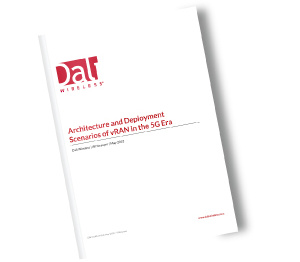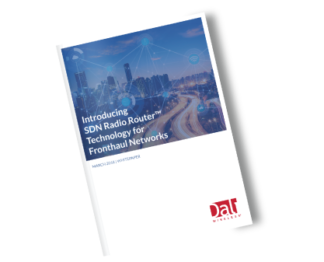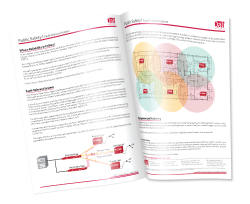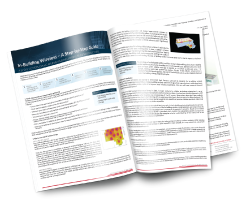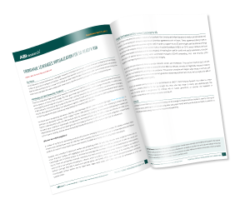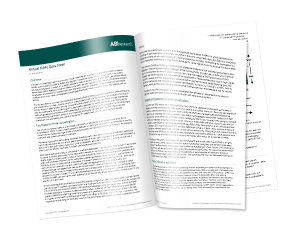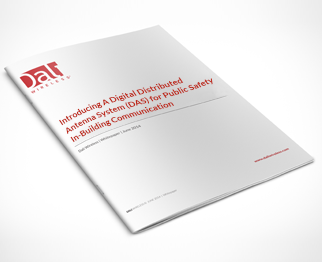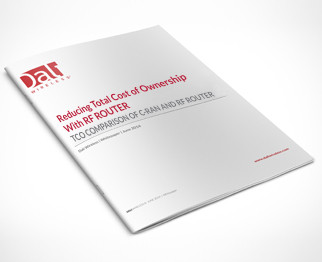Architecture and Deployment Scenarios of vRAN in 5G Era
Service requirements for 5G make flexibility in network architecture an imperative requirement. In contrast to previous generations, 5G targets applications beyond personal mobile broadband services to include services in different industry verticals. The broad scope of applications leads to contradictory requirements which mandate a flexible network architecture.
To achieve this flexibility, 5G disaggregates the network into different functions whose location is best defined by the requirements and economics of the use case. 5G leverages virtualization to implement these functions. The result of this is exposing the fronthaul, the connection between these functions, as the bond that holds the radio access network (RAN) together.
Fronthaul in the 5G era takes on a critical role in enabling different deployment scenarios. In this white paper, we highlight the requirements for fronthaul in modern networks and describe different use cases that illustrate how fronthaul is used to achieve flexibility in the wireless access network to achieve functional and economic requirements.
Introducing SDN Radio Router™ for Fronthaul Networks
Not only will more people be connected with 5G, many devices, machines, cities, and infrastructures will also be connected. While the applications and use cases of 5G are no doubt very exciting, it’s important to remember that 5G is yet another network rollout for the mobile operators.
Keeping in mind that they’ve already invested billions into their existing infrastructure, it is important to leverage as much of this investment as possible in migrating to 5G. Supporting legacy 2G, 3G and 4G networks is just as important as modernizing the networks in preparation for 5G. Having a fronthaul network in place that is backward compatible is vital.
Download this whitepaper to learn how Dali Wireless SDN Radio Router™ extends the virtualization to the fronthaul to enable an open RAN that will not only maximize the usage of mobile operators’ existing 2G, 3G and 4G infrastructure, but will serve as the foundation for 5G and network expansion for generations yet to come.
Fault-Tolerant Public Safety System
First responders require seamless service at all times and cannot afford to experience disruptions in communications for any reasons. Staying connected at ALL times is a baseline requirement for an Emergency Responder Radio Coverage System (ERRCS).
Although redundancy is not a mandatory requirement, it is one factor to be considered to minimize single point failures in a public safety wireless communications system to provide the desired reliability. The most basic form of network redundancy is duplicating the system in its entirety, 1:1 redundancy. Full system redundancy is ideal and very effective, but in many situations, it may not be an option due to space and cost.
In this article, an alternative and cost effective method will be described – a fault tolerant system.
In-Building Wireless – A Step-by-Step Guide
Implementing a new in-building wireless system is a large project that can be overwhelming. This document will guide you through the steps involved in designing and implementing an in-building wireless infrastructure for both new and existing buildings, and will highlight some common errors to avoid.
ABI Insight: Fronthaul Leverages Virtualization For 5G-ready V-RAN
Next-generation fronthaul is a core foundation of emerging V-RAN networks in the sense that it enables the execution of centralized access protocol functions and allows advanced dynamic capacity routing. Next-generation fronthaul is access protocol agnostic, software configurable, and supports MIMO and massive MIMO and is key to lowering equipment space and energy requirements for reduced CAPEX and OPEX.
Read this ABI paper to learn more about the drivers of fronthaul innovation and current industry trends.
ABI Insight: Virtual RAN Gets Real
The modern RAN is evolving from traditional distributed RAN (D-RAN) and centralized RAN (C-RAN) architectures to a virtual RAN (V-RAN) architecture where many of the functions of the baseband are executed in the cloud on remote telecom data centers running commercial off-the-shelf (COTS) hardware.
These changes fundamentally alter the relationship and partitioning in the basestation between the radios, basebands, data centers, and the underlying transport or fronthaul interconnecting them.
Read the ABI paper, “Virtual RAN Gets Real”, to gain a better understanding of this shift in RAN architectures, the various forms it can take and the implications for the fronthaul.
Introducing A Digital Distributed Antenna System (DAS) For Public Safety In-Building Communications
Reliable public safety radio communications are vital in today’s emergency services operation, from dispatch to mission critical situations, and from voice only capabilities to voice and data.
Public safety communications have evolved from fire call boxes, analog land mobile radios (LMR) to digital LMRs and trunked radio systems. This evolution was mainly driven by technological advancements and the need for higher reliability.
Introducing Dali Matrix™ Public Safety (PS) – the next generation all-digital Distributed Antenna System (DAS) to meet the stringent requirements of reliability and the evolving needs and requirements of public safety including broadband, LTE and FirstNet.
Reducing Total Cost of Ownership With RF ROUTER – TCO Comparison of C-RAN and RF ROUTER
A comparison of total cost of ownership (TCO) for a C-RAN and a RF Router solution has been calculated on the basis of an existing typical airport campus, applying identical business requirements for both solutions.
• Compared to a C-RAN solution under same conditions, the RF Router solution offers
typically 30…40% better TCO performance over a 3-year period. Up to 60% better
TCO can be achieved for multi-operator use cases.
• Evaluating just initial CAPEX provides an incomplete picture – it’s an OPEX game.
• Hidden costs of operational complexity are a major contributor to TCO
• C-RAN is currently mentioned only in 4G context. Nothing prevents from deploying this architecture also in 3G or 2G, but no known commercial products are available to date.
• C-RAN requires all base stations to be collocated in a single location due to mechanical coupling of baseband units. A RF Router based solution can be distributed over a wide area with up to 40 km distance between base station locations. In addition to the cost benefit, scalability and elasticity of the RF Router solution unlocks new business opportunities for operators by enabling a virtualized radio access network (v-RAN).
Download Whitepaper